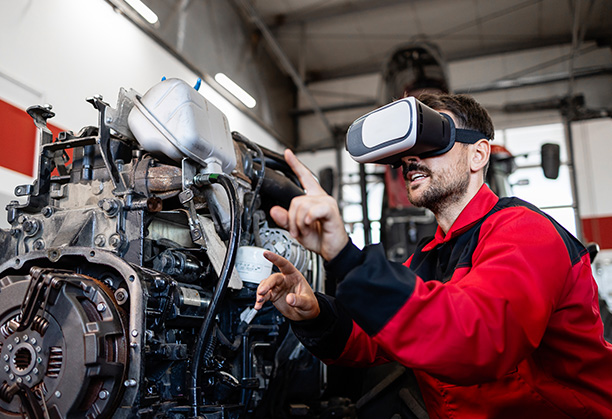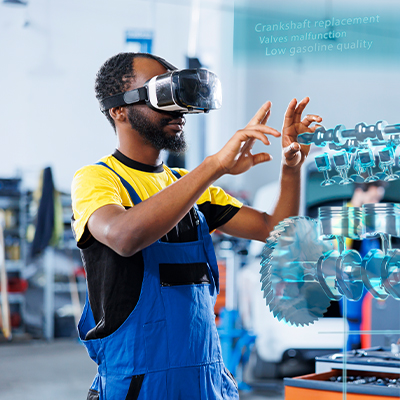Virtual Reality has revolutionized the automotive industry by providing immersive, interactive simulations that replicate complex processes, from vehicle design to manufacturing and maintenance, in a risk-free virtual environment.
This hands-on approach offers significant advantages over traditional methods. Designers can visualize and iterate vehicle models swiftly, reducing the need for physical prototypes and accelerating development cycles. Technicians and assembly line workers can practice intricate procedures repeatedly, enhancing precision and confidence before applying skills on the factory floor. This not only improves safety but also reduces training costs and downtime.
VR Modules in Automotive Training
1. Vehicle Assembly Training Modules
These modules are designed to help workers understand and practice the entire vehicle assembly process—from chassis construction to final inspections. By simulating a virtual factory floor, trainees can learn the correct sequence of steps, identify assembly errors, and follow safety procedures—all without needing access to real components. This type of training is especially useful for onboarding new factory workers and upskilling existing teams.
2. Engine and Mechanical System Simulations
Mechanics and service technicians benefit significantly from VR modules focused on the inner workings of engines, transmissions, brake systems, and suspensions. These modules offer a 3D breakdown of complex parts, interactive repair tasks, and real-time feedback. Users can disassemble and reassemble virtual components, understand diagnostic procedures, and learn fault-finding techniques without risk of damage.
3. Electrical and Diagnostic Training
Modern vehicles are becoming increasingly reliant on electronics and software. VR modules for electrical systems help technicians understand wiring diagrams, troubleshoot electronic control units (ECUs), and simulate diagnostic procedures using virtual scan tools. These simulations enhance problem-solving skills and help bridge the gap between theory and practice.
4. Body Shop and Paint Training Modules
For professionals in auto body repair and painting, VR modules offer virtual spray painting experiences and dent repair scenarios. These modules replicate the precision and motion control required for high-quality paint jobs, allowing users to practice techniques like masking, color matching, and blending—all without wasting materials.
5. Driver and Safety Training Simulations
These modules are valuable for both test drivers and safety personnel. They simulate high-risk driving scenarios, such as adverse weather conditions, collision avoidance, and emergency braking, to train drivers in safe vehicle operation. Additionally, safety modules can simulate workplace hazards and teach compliance with occupational safety standards.

Applications of VR in Automotive
Technical Skills Development
VR provides significant support in developing technical skills related to vehicle diagnostics, repair, and assembly. Trainees can interact with virtual engines, transmissions, and other components to gain a deep understanding of their inner workings. For instance, a VR simulation might allow a trainee to disassemble and reassemble an engine, providing hands-on experience without the need for a physical engine. This approach complements modern strategies in how AI and machine learning help in automotive diagnostics.
Safety Training
Safety is a critical aspect of automotive training, especially when dealing with high-voltage electric vehicles (EVs) or heavy machinery. VR can simulate dangerous scenarios, such as electrical fires or battery malfunctions, enabling trainees to practice appropriate safety procedures. This not only improves their response to real-life emergencies but also ingrains a strong safety culture.
ADAS and Autonomous Vehicle Training
As ADAS and autonomous vehicles become more prevalent, the need for specialized training in these areas is increasing. VR can simulate driving conditions and scenarios that are difficult or impossible to recreate in the real world, such as complex urban environments, adverse weather conditions, or emergency situations. This allows trainees to develop the skills necessary to diagnose, repair, and calibrate ADAS systems effectively.
Soft Skills and Customer Interaction
In addition to technical skills, VR can be used to train automotive professionals in soft skills such as customer service, sales, and team communication. By simulating customer interactions or team meetings, VR helps trainees develop the interpersonal skills necessary for success in the automotive industry, aligning with best practices in the role of corporate training in automotive innovation.
Benefits of Using VR in Automotive
Enhanced Learning Retention
Virtual Reality provides an immersive learning environment that involves multiple senses, leading to better retention of information. Trainees can interact with virtual components, visualize complex systems, and experience realistic scenarios that reinforce learning. VR training can lead to higher retention rates compared to traditional methods, especially when integrated with continuous learning in the automotive industry.
Safe Controlled Training Environment
VR enables trainees to practice tasks and procedures in a risk-free environment. This is particularly valuable in automotive training, where working with high-voltage systems, heavy machinery, or hazardous materials can pose significant safety risks. With VR automotive training, trainees can make mistakes and learn from them without the fear of injury or damage to expensive equipment.
Cost-Effective
Implementing VR in training programs can result in significant cost savings. While the initial investment in VR technology is substantial, the long-term benefits include reduced need for physical vehicles, components, and training facilities. Additionally, VR training can be conducted remotely, reducing travel and accommodation expenses for both trainers and trainees.
Scalability and Flexibility
VR training programs can be easily scaled to accommodate a large number of trainees across multiple locations. Virtual environments can be customized to meet the specific needs of different training modules, whether it’s a focus on electric vehicle (EV) systems or traditional internal combustion engine (ICE) maintenance. This flexibility allows for the continuous updating of training content as new technologies emerge, in line with trends towards the shift to sustainable automotive practices.

Challenges in Opting VR
High Initial Cost
While VR offers long-term cost savings benefits, the initial investment in VR hardware, software, and content development can be substantial. Organizations must weigh these upfront costs against the potential benefits, including improved training outcomes and reduced operational expenses.
Technological Barriers
Implementing VR training requires access to advanced hardware and software, as well as the technical expertise to develop and maintain VR content. This can be a challenge for organizations that lack the necessary infrastructure or experience in VR technology.
User Acceptance and Adaptation
Some trainees and trainers may be resistant to adopting new technologies, especially if they are accustomed to traditional training methods. It then becomes critical to provide all the required support and training to ensure that all employees are comfortable with the VR systems and can fully benefit from the technology.
Content Development
Developing high-quality, realistic VR training content requires collaboration between automotive experts, instructional designers, and VR developers. Ensuring that the content is accurate, engaging, and aligned with training objectives is critical to the success of VR training programs.
Ready for risk-free automotive training?
Juego neXR: Transforming Automotive Training with VR
At Juego neXR, we craft cutting-edge Virtual Reality training environments that redefine how automotive professionals learn complex tasks. Our immersive simulations recreate workshop and road scenarios with precision, enabling trainees to practice diagnostics, repairs, and safety protocols without real-world risks.
With hands-on interactivity, repeatable sessions, and real-time performance feedback, our VR training modules reduce accidents, boost skill retention, and cut training costs. Designed for scalability and realism, Juego neXR’s automotive training solutions are built to enhance safety, confidence, and efficiency across the automotive service and manufacturing industries.
Conclusion
Virtual Reality has revolutionized modern automotive training by providing immersive, interactive, and scalable solutions that enhance learning outcomes. As vehicles and systems become more complex, the need for advanced training methods that can keep pace with technological advancements is critical. VR offers a flexible and cost-effective alternative to traditional training, allowing automotive professionals to develop the skills and knowledge necessary to excel in a rapidly evolving industry.
Despite the challenges associated with implementing VR, the long-term benefits, including improved safety, reduced costs, and higher retention rates, make it a valuable investment for organizations committed to excellence in automotive training.
Frequently Asked Questions
While both forms of training have their pros and cons, here are a few crucial differences between the two training methods:
| Aspects | Traditional Training | VR Training |
| Learning Environment | Classroom-based, physical hands-on | Immersive, virtual simulation |
| Cost | High (due to physical resources, travel, and more) | High initial investment, but lower long-term costs |
| Safety | Real-world risks during hands-on training | Safe, controlled environment without physical risks |
| Scalability | Limited by resources and location | Highly scalable, can accommodate multiple trainees remotely |
| Flexibility | Rigid, dependent on physical availability of components | Flexible, customizable virtual scenarios |
| Retention Rates | Lower due to traditional teaching methods | Higher due immersive and interactive nature |
VR training offers a safer, more flexible, and scalable alternative to traditional automotive training, with the added benefit of higher retention rates. While the initial investment may be high, the long-term advantages in safety, cost efficiency, and learning outcomes make VR a compelling choice for the future of automotive education.
Automotive companies can reduce VR training costs by adopting scalable Extended Reality solutions that use modular content and cloud-based deployment. Instead of custom-building each training module, companies can leverage reusable VR frameworks tailored for tasks like assembly, maintenance, and safety.
Integrating VR into automotive training requires aligning immersive modules with current learning objectives, ensuring seamless compatibility with existing systems, and prioritizing real-world accuracy in simulations. Start with pilot programs to gather feedback, train instructors in XR facilitation, and iterate based on outcomes. It’s crucial to balance theoretical knowledge with interactive VR sessions for optimal retention.
VR technology has become increasingly accessible for small and medium-sized automotive companies, thanks to declining hardware costs and scalable development platforms. Solutions like affordable headsets, cloud-based deployment, and modular training systems now allow even modest budgets to integrate VR for design visualization, prototyping, and workforce training.
Revolutionize the future of business with Juego neXR
Related Posts
Share this Article:
Our Offices

India
Bangalore
GR Grand Plaza, 2nd Floor, JP Nagar, 6th Phase, Bangalore – 560 078

KSA
Jeddah
St Idris Square, 4036 Helmi Koutbi, Al Zahra, Jeddah 23425, Saudi Arabia
Follow Us On:
© 2025 Juego neXR. All Rights Reserved.


